Kassel
| Kassel | |
| Coat of arms | Location |
 |
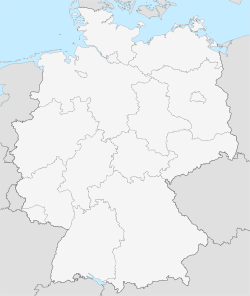 |
| Administration | |
| Country | Germany |
|---|---|
| State | Hesse |
| Admin. region | Kassel |
| District | Urban district |
| Mayor | Bertram Hilgen (SPD) |
| Basic statistics | |
| Area | 161 km² (62.2 sq mi) |
| Elevation | 167 m (548 ft) |
| Population | 193,518 (30/12/2006) |
| - Density | 1,202 /km² (3,113 /sq mi) |
| Other information | |
| Time zone | CET/CEST (UTC+1/+2) |
| Licence plate | KS |
| Postal codes | 34001–34134 |
| Area code | 0561 |
| Website | www.stadt-kassel.de |
Kassel [ˈkʰasəl] (until 1926 officially Cassel) is a city situated along the Fulda River in northern Hessen, Germany, one of the two sources of the Weser river . It is the administrative seat of the Kassel administrative region (Regierungsbezirk) and of the district (Kreis) of the same name. The city has c. 198,500 inhabitants (2007) and covers an area of 106.77 square kilometres. Kassel is the largest city of the north of Hessen (Nordhessen).
Contents |
History
The city's name is derived from the ancient Castellum Cattorum, a castle of the Chatti, a German tribe that has lived in the area since Roman times.
Kassel as such is first mentioned in 913 as the place where two deeds were signed by king Conrad I. The place was called Chasella and was a fortification at a bridge crossing the Fulda river. A deed from 1189 certifies that Kassel had city rights, but the date of their conveyance is not known.
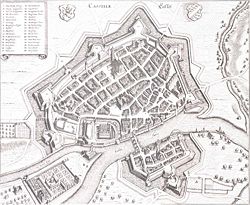
In 1567 the landgraviate of Hesse, until then centered in Marburg, was divided among four sons, with Hesse-Kassel (or Hesse-Cassel) becoming one of its successor states. Kassel was its capital and became a centre of Calvinist Protestantism in Germany. Strong fortifications were built to protect the Protestant stronghold against Catholic enemies. In 1685 Kassel became a refuge for 1700 Huguenots who found shelter in the newly established borough of Oberneustadt. Landgrave Charles, who was responsible for this humanitarian act, also ordered the construction of the Oktagon and of the Orangerie. In the late 18th century Hesse-Kassel became infamous for selling mercenaries (Hessians) to the British crown to help suppress the American Revolution and to finance the construction of palaces and the landgrave's opulent lifestyle.
In the early 19th century the Brothers Grimm lived in Kassel and collected and wrote most of their fairy tales. At this time (1803) the landgravate was elevated to a principality and its ruler to Prince-elector. Shortly after, it was annexed by Napoleon and, in 1807 became the capital of the short-lived Kingdom of Westphalia under Napoleon's brother Jérôme. The electorate was restored in 1813.
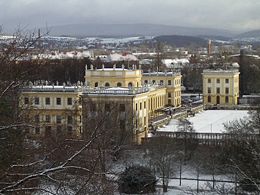
Having sided with Austria in the Austro-Prussian War for supremacy in Germany, the principality was annexed by Prussia in 1866. The Prussian administration united Nassau, Frankfurt and Hesse-Kassel into the new Prussian province of Hesse-Nassau. Kassel ceased to be a princely residence, but soon developed into a major industrial centre as well as a major railway junction.
In 1870 after the Battle of Sedan, Napoleon III was sent as a prisoner to the castle of Wilhelmshöhe above the city.
World War II
Kassel was the Headquarters for Germany’s Wehrkreis IX. This Wehrkreis included part of Thuringia and part of Hesse. The Commander was General der Infanterie Schellert.
Wehrkreis XII was made up of three Bereich Hauptsitze: Kassel; Frankfurt am Main; and Weimar.
Bereich Hauptsitze Kassel was the headquarters for nine Unterregion-Hauptsitze, namely Kassel I; Kassel II; Korbach; Marburg (Lahn); Hersfeld; Siegen; Wetzlar; Fulda; and Giessen.
Bereich Hauptsitze Frankfurt am Main was the headquarters for six Unterregion-Hauptsitze, namely Frankfurt am Main I; Frankfurt am Main II; Offenbach (Main); Aschaffenburg; Friedberg; and Hanau.
Bereich Hauptsitze Weimar was the headquarters for nine Unterregion-Hauptsitze; namely Weimar; Sangerhausen; Gera; Rudolstadt; Mulhausen (Thuringia); Erfurt; Eisenach; Gotha; and Meiningen.
During World War II, a subcamp of Dachau concentration camp was located here. The inmates provided slave labour for Henschel.[1] During the night of October 22/23, 1943, 569 British bombers razed Kassel (see: Bombing of Kassel in World War II), destroying 90% of the city centre; some 10,000 people died in the raid and 150,000 were rendered homeless, in a firestorm comparable to the one in Hamburg in July 1943. The attack had been disguised by a feint attack on Frankfurt am Main that commenced five minutes before the raid on Kassel. By far most of the casualties were civilians or wounded soldiers recuperating in local hospitals, whereas Kassel's heavy weapons factories survived the attack generally undamaged. The attack included one of the most accurate target markings since the Hamburg firestorm raid. On the night of the Kassel firestorm raid RAF Bomber Command introduced Operation Corona to confuse the German nightfighters, making the raid a complete success -- so devastating that the regional Gauleiter, Karl Weinrich, was removed from his post soon after. He was replaced by Karl Gerland.
The US First Army captured Kassel on April 3, 1945. After the war, most of the ancient buildings were not restored, and large parts of the city centre were completely rebuilt in the style of the 1950s. A few historic buildings, however, such as the Museum Fridericianum (see below), were restored.
There is a frequently repeated legend among Kassel citizens alleging that the city was close to becoming the provisional capital of the Federal Republic of Germany in 1949. It is true that the interim parliament ("Parlamentarischer Rat") was at that time considering a new location for the capital, since Berlin was then a special administrative region controlled directly by the allies and surrounded by the Soviet zone of occupation. A number of cities were proposed to host the federal government, but Kassel was eliminated in the first round. Most of the members of the German constitutional assembly (as well as the U.S. Supreme Command) favoured Frankfurt am Main where the Hessian administration had already started the construction of a plenary assembly hall. In the end Bonn won after Chancellor Konrad Adenauer intervened emphatically for Bonn which was only fifteen kilometers away from his hometown.

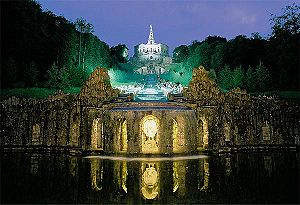
Main sights
Due to the destruction of 1943, the city was almost completely rebuilt in the 1950s. Hence there are very few old buildings in the centre. The oldest monument is the "Druselturm". The "Brüderkirche" and the St. Martin Church are also in part of medieval origin, but the towers of St. Martin are from the 1950s.
What historic buildings have survived are mainly outside the center of town. Wilhelmshöhe Palace, above the city, was built in 1786 by landgrave Wilhelm IX of Hesse-Kassel. The palace now is a museum and houses a world-famous wall paper collection, an important collection of graeco-roman antiques and a fine gallery of paintings comprising the second largest collection of Rembrandts in Germany. It is surrounded by a beautiful park with many appealing sights. The Oktagon is a huge octagonal stone structure carrying a giant replica of Hercules "Farnese" (now at Museo Archeologico Nazionale in Naples, Italy). From its base down to Wilhelmshöhe Palace runs a long set of artificial cascades which delight visitors during the summer months. The Löwenburg ("Lions Castle") is a replica of a medieval castle, also built during the reign of Wilhelm IX. After the Franco-Prussian War of 1870/71 Napoléon III was imprisoned in Wilhelmshöhe. In 1918 Wilhelmshöhe became seat of the German Army Command (OHL): it was there that the military commanders Hindenburg and Ludendorff prepared the German capitulation.
Another large park is the Karlsaue along the Fulda River. Established in the 16th century, it is famous for the Orangerie, a palace built in 1710 as a summer residence for the landgraves. Today there is also a planetarium in the park.
Kassel is scene of Documenta, an important international exhibition of modern and contemporary art. Museums include: Schloss Wilhelmshöhe (Antiquities Collection and Old Masters; wall paper museum), Museum für Sepulkralkultur (the only German Museum of the culture of funerals); Art Gallery (Albrecht Dürer, Rubens, Rembrandt, Frans Hals, Anthony van Dyck), New Gallery (Tischbein Family, Joseph Beuys).
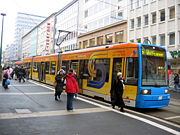
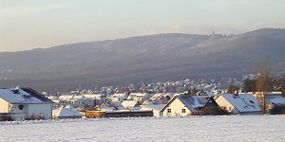
Transportation
The city operates a tramway system; a Stadtbahn-like system with light rail vehicles running on both main line rail and tram tracks, called RegioTram, is currently being deployed. The city also operates buses, and was responsible for the development of the Kassel kerb which improves the alignment of modern low-floor buses with bus stops.
The city is connected to the DB network by two stations, Kassel Hauptbahnhof, the traditional central station that has been reduced to the function of a regional station since the opening of the Hanover-Würzburg high-speed rail line in 1991, and Kassel-Wilhelmshöhe, the station on said high-speed line where InterCityExpress and InterCity services call at.
Regarding autobahn services, Kassel is connected to the A 7, A 49 and A 44.
University
The University of Kassel was founded in 1971, and is the newest university in the state of Hesse.
Miscellaneous
In 1558 the first German observatory was built in Kassel, followed in 1604 by the Ottoneum, the first permanent theater building, and in 1779 by Europe's first public museum, named the Museum Fridericianum after its founder. By the end of the 19th century the museum held one of the largest collections in the world of watches and clocks. Since 1955 the documenta, an international exhibition of modern and contemporary art, has been held regularly in Kassel. The documenta now takes place every 5 years and the next will be in mid-2012. As a result of the documenta 6 (1977), Kassel has become the first town worldwide, that was illuminated by LASER-beams at night (Laserscape, by artist Horst H. Baumann).
Famous people
Famous inhabitants of Kassel include Jerome Bonaparte, brother of Napoleon Bonaparte, while he was king of Westphalia; the Brothers Grimm; F. W. Murnau, the movie director; Paul Reuter, founder of the Reuters news agency; Franz Rosenzweig, philosopher, Philipp Scheidemann, briefly Germany's Chancellor after World War I; and Louis Spohr, the 19th-century composer and violinist, who is commemorated by a museum in the city. Astrid and Thorwald Proll, members of the German terrorist group the Red Army Faction (also known as the Baader-Meinhof gang) active during the 1970s and 1980s, were born here in 1947 and 1941, respectively. Kassel is also the birthplace of Annika Mehlhorn, a German butterfly and medley swimmer who competed in the 2004 Summer Olympics. Helmut Hasse (1898 - 1979) did fundamental work in algebra and number theory.
Twinning
Kassel is twinned with
References
- ↑ Edward Victor. Alphabetical List of Camps, Subcamps and Other Camps.www.edwardvictor.com/Holocaust/List %20 of % 20 camps. htm
External links
- Kassel City Panoramas - Panoramic views and Virtual Tours
- Official website
- Kassel travel guide from Wikitravel
- University of Kassel
|
||||||||
